On this page:
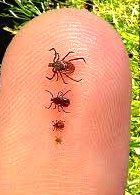 Lyme disease and other tick-borne illnesses.
Lyme disease and other tick-borne illnesses.- Tick identification.
- Tick bite prevention.
- How to Remove a Tick (with video).
- Testing ticks for disease.
- When to contact a health care provider.
- Talk to your children about ticks.
Lyme disease and other Tick-borne illnesses
New tick-borne diseases have been discovered in recent years with infections steadily increasing. Lyme disease is the most commonly reported in New York. Like Lyme, the other diseases will begin to spread to other regions across the state. As these diseases become more common, it's important to learn how to identify and remove ticks, and what to do if you think you might have a tick-borne disease. Preventing a tick bite is your best defense against tick-borne diseases.
For more information on Lyme disease visit:
Tick Identification
The ticks responsible for the majority of tick-borne diseases in humans are the black legged deer tick, American dog tick and the lone star tick. These species are found primarily in the Northeastern and upper Midwest regions of the United States, and may transmit several different diseases.
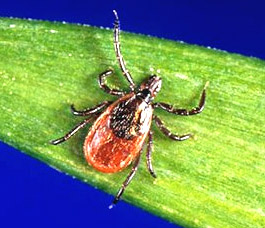 |
Black Legged Deer Tick transmits: Lyme disease, anaplasmosis, babesiosis, Powassan |
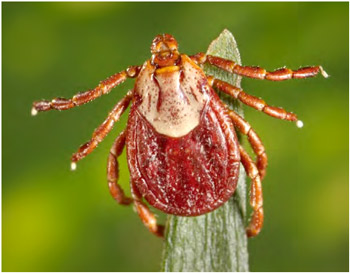 |
American Dog Tick transmits: Tularemia, Rocky Mountain Spotted Fever |
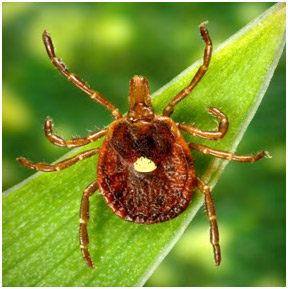 |
Lone Star Tick transmits: ehrlichoisis, tularemia, STARI |
The tick life cycle generally lasts two years. During this time, they go through four life stages: egg, six-legged larva, eight-legged nymph, and adult. The nymphs are most active in early spring and are the size of a poppy seed. They can still transmit disease if they bite, so it is important to be vigilant with daily full body tick checks.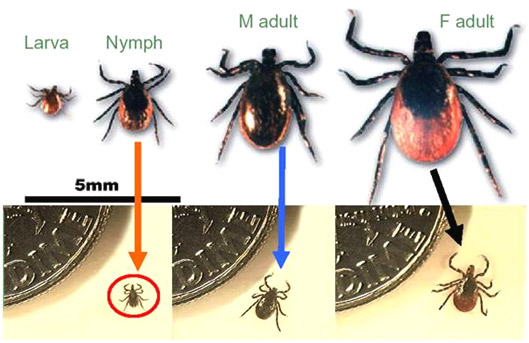
Tick bite Prevention
Follow the “ABCs” of tick bite prevention.
A: Avoid ticks
Ticks live in tall grass, bushy thick wooded areas, in leaf piles and along stone walls. Walk in the center of well marked trails. Ticks hold their upper pair of legs outstretched, waiting to climb onto a passing host. When a host brushes the spot where a tick is waiting, it quickly climbs aboard. It then finds a suitable place to bite its host.
B: Bug spray
Use insect repellent that contains 20%-30% DEET. Apply as directed and avoid eyes or mouth. Assist children with applying insect repellent. Treat your clothing, tents and other camping gear with permethrin. Be sure to follow instructions from the manufacturer.
C: Check yourself
Perform a daily full body tick check. Remember that nymphs are very small and may be very hard to see. Be sure to check your scalp, ears, under your arms, waist line, and groin area, behind your knees and your ankles. Check your children and your pets every day after they have been outdoors.
D: Dress to repel
Wear light-colored clothing (so you can see the ticks and remove them). Wear a long-sleeved shirt and long pants. Tuck pants into socks and shirts into pants.
For more information on preventing tick bites on your pets visit this page on the CDC website.
How to Remove a Tick
 Remove ticks as soon as possible to reduce your risk of getting infected with Lyme disease or other tick-borne illnesses.
Remove ticks as soon as possible to reduce your risk of getting infected with Lyme disease or other tick-borne illnesses.
- Using a pair of fine tipped tweezers, grasp tick near the mouth parts, as close to skin as possible.
- Pull tick in a steady, upward motion, away from skin. Avoid twisting, jerking, or squeezing the tick.
- Disinfect site with soap and water, rubbing alcohol or hydrogen peroxide.
DO NOT use kerosene, matches, or petroleum jelly to remove ticks.
Video: How to Remove a Tick (NYSDOH, 2 minutes).
May not play in all browsers.
Click here for more videos about tick prevention from the NYSDOH.
Should a tick be tested for disease?
People who have removed a tick often wonder if they should have it tested. The US Centers for Disease Control and Prevention recommends that the testing of individual ticks is not useful because:
- The testing of ticks for the presence of the bacteria that causes Lyme disease has no role in the clinical diagnosis of Lyme disease.
- If the test shows the tick contained disease-causing organisms, that does not necessarily mean that you have been infected.
- If someone has been infected by a tick bite, symptoms may begin to occur even before the results of tick testing are available. People should not to wait for tick testing results before seeking medical advice should any symptoms develop.
- Negative results can lead to false assurance. For example, you may have been unknowingly bitten by a different tick that was infected.
- Tests performed on the ticks are not perfect and they do not test for all infections ticks may be carrying. Therefore, even with a negative result, people should still monitor themselves for the appearance of rash, fever or other unusual symptoms and immediately seek the advice of a health care provider should any symptoms occur.
- A positive test on a tick is not an automatic indication that treatment is needed. A positive test indicates that the tick was infected but not that the tick was successful in spreading the infection to the person bitten. The longer a tick is attached to you, the greater the chance that it will spread infection.
When to contact your health care provider
- If you are unable to remove all the mouthpieces, they should fall out on their own.
- If you are concerned about the attachment site, contact your health care provider.
- If you experience fever, chills, body aches and pains, flu like symptoms, facial paralysis or rash after being outdoors, contact your health care provider.
- Most tick-borne diseases, including Lyme disease, can be successfully treated with antibiotics especially if treatment is started early.
Talk to your children about ticks!
“Once Upon a Lyme” video, from Kaitlyn Guay
“Get Tickless” video, from Kaitlyn Guay
From “Don’t Get Ticked” — NYS Integrated Pest Management, Cornell Univ.

